A look at the global empires and family-owned businesses shaping fire protection
Today’s fire sprinkler manufacturers—including those that largely serve the USA and Canada—may all seem to offer kind of the same thing. Much of that perception is because fire sprinkler heads and other fire safety products must, for safety’s sake, meet similar manufacturing and design standards.
But every major producer has a catalog that builds on decades or even a century’s worth of specialized experience. And each company’s history—from its founder’s choices to its future acquisitions—has lasting repercussions. Some stand as authorities in a broad range of billion-dollar industries. Other manufacturers focus almost exclusively on fire sprinkler heads. All make unique contributions to safety in modern buildings.
Read on to learn about the contributions and current offerings of major fire sprinkler manufacturers like:
- Reliable (Reliable Automatic Sprinkler or RASCO)
- Senju Sprinkler
- Tyco (along with acquisitions like Central, Gem, Grinnell, and Star)
- Victaulic (and the recently-purchased Globe Sprinkler)
- Viking (the Viking Corporation)
To get a taste of these manufacturers’ offerings—from sprinkler heads to pipe fittings—browse our website.
Reliable, a fire sprinkler manufacturer based in the USA, celebrates a century in water-based fire protection
Short take: A steamfitter’s sons steer a multi-million-dollar manufacturing and distribution business into the 21st century.
Reliable—otherwise known as the Reliable Automatic Sprinkler Company or RASCO—turns 100 this year. When they say it’s a “family-owned business,” they mean it: descendants of Frank J. Fee, Reliable’s founder, hold the titles of board chairman, president, advisor, and vice presidents. Fee, an Irish immigrant, began work as a plumber and steamfitter who, unable to buy sprinklers elsewhere, simply began making his own.
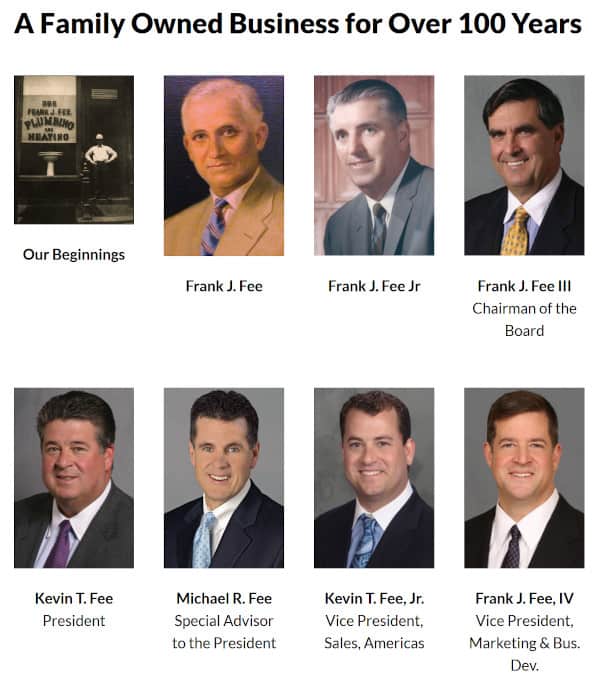
Reliable offers fusible-link and glass-bulb sprinklers, along with components as wide-ranging as deluge valves, nipples, and air compressor equipment. In the past two years, they’ve moved forward by introducing:
- Window protection sprinklers. Model WP Series heads work to maximize allowable spacing between sprinklers—with an “industry-leading listing of 12 [feet]”—and minimize the water required.
- New and relocated distribution centers in Capitol Heights, Maryland, and Richmond, Virginia. RASCO maintains a strong presence along the east coast, the central US, and elsewhere.
- Impact-resistant fire sprinkler heads for commercial buildings and in-rack storage. The company’s KFR-series heads feature a fusible link rather than a glass bulb, allowing them to be shipped and installed without protective covers. Each thermal link is inspected by X-ray—and the series includes guards, shields, and wrenches.
We’ll learn more about RASCO this year, as the company celebrates its centennial. But early glimpses of the festivities include a look at antique water motor gongs, historic glass-bulb sprinklers, and even a quaint ashtray/sprinkler head combination from the mid-1970s.
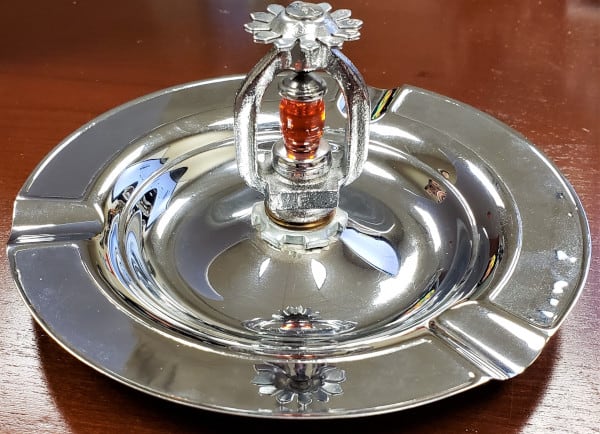
Senju Sprinkler, a latecomer among fire sprinkler head manufacturers, specializes in what’s easy on the eyes
Short take: Solid manufacturing, a long line of handsome fire sprinklers, and an expansive catalog of stock cover plate finishes have rapidly boosted Senju’s North American presence.
Senju Sprinkler can’t match other manufacturers’ lengthy histories—but it’s catching up quickly. After releasing its first sprinkler head in 1963, the Japan-based company quickly established a presence in the nation’s high-rise buildings. Today, Senju’s expanded catalog of valves, fire sprinklers, and safety equipment stands toe-to-toe with the offerings of industry giants. According to the company’s estimates, a whopping 70% of sprinklers and related products sold in Japan come from Senju.
In the early 1990s, Senju’s Model ZN—a sleek, concealed fire sprinkler head—earned the approval of the leading North American safety organizations UL and FM. Since then, its line of aesthetically pleasing heads has expanded to include a variety of commercial and residential sprinklers, like the ZN-QR, HF-RES, ZN-RES, and more.
As we’ve covered in our look at fire sprinkler types, Senju’s trend-setting line of sprinkler cover plates set the company apart. Like other fire sprinkler manufacturers, Senju offers a healthy line of metallic finishes. But it’s their stock collection of wood-grain patterns—and rapid turnaround for custom-printed plates—that really shine. Senju tries to do away with the practice of aftermarket painting and the potentially deadly risks that follow applying DIY paint to sprinklers.
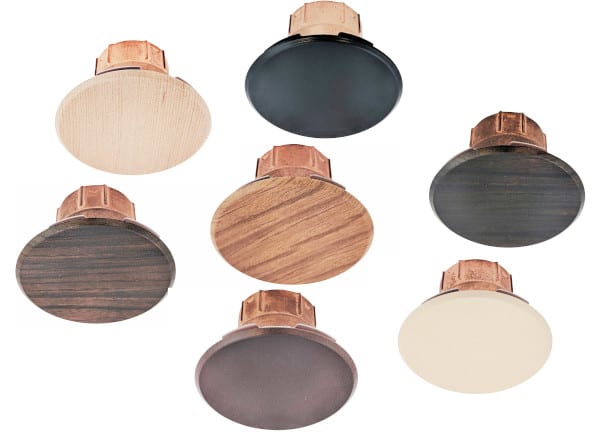
Tyco (and Central, and Gem, and Grinnell, and Star…) has a massive footprint among fire sprinkler manufacturers
Short take: Rapid acquisitions have fueled the growth of a multi-billion-dollar company with more than 100,000 employees. Today, Tyco International does far more than make fire protection equipment.
Tyco has been around since 1960—but the fire sprinkler manufacturers and other organizations now under its corporate umbrella have histories that extend to the middle of the 19th century. We’ve covered a few major acquisitions that have made some sprinkler lines obsolete, including:
- Central Sprinkler Company (CSC or Central). After a series of devastating lawsuits and recalls, Tyco ended this Pennsylvania-based company’s 30-year run with a 100-million-dollar purchase.
- Gem and Grinnell. These companies joined Tyco in the 1970s, but Gem’s run as a brand-name fire sprinkler manufacturer continued for decades—until it was consumed by the same massive fire sprinkler recall that took out Central. Both organizations bring more than a century’s worth of experience to the table.
- Star Sprinkler. Like Central, Star joined Tyco in the 1990s, bringing a hundred years in fire protection to a close.
Incorporated in Ireland and headquartered in New Jersey, Tyco International’s reach spans five continents and various industries as wide-ranging as electronics, healthcare, fire protection, and security. Press releases for the last 20 years show a company engaged in aggressive innovation, with the release of new products like:
- The first UL-listed antifreeze solution for wet-pipe fire sprinkler systems.
- New lines of “poly-stainless” sprinklers—available for the TY-B and TY-FRB models—for highly corrosive
- Various early suppression, fast response (ESFR) heads made to reduce the costs of protecting storage facilities against fire.
- RAVEN Studio sprinklers, which include an “industry-first option to paint escutcheons in the field, even after installation.”
Victaulic expands from a wartime industry to a leading name in fire protection and pipe joining
Short take: Victaulic began in the pipefitting industry—and it shows. Grooved pipes and couplings remain at the company’s core. But the company’s experience with sprinkler manufacturing (and a recent acquisition of Globe Sprinkler) strengthens Victaulic’s standing in the industry.
Victaulic’s storied history stretches back to World War I, where grooved pipes—a product that would later become the company’s bread-and-butter innovation—made the rapid distribution of fuel and water possible. The Victory Pipe Joint Company wouldn’t form until the year after the war’s close, but in the decades to come, grooved products would proliferate, protecting underground cables, delivering fuel underwater, and serving as plumbing aboard warships.
Although it’s been in business for more than 100 years, Victaulic spent much of that time as a maker of grooved pipe and fittings. It wasn’t until 1997 that it created an affiliated company tasked with fire protection (although patents suggest Victaulic developed related products in the years prior). Since then, Victaulic has fleshed out a full catalog of commercial and residential fire sprinklers with innovations like:
- Specialized brackets that allow installers to adjust sprinkler height even against hard ceilings.
- Flexible dry sprinklers designed to prevent damage from expanding ice.
- “Installation-ready” storage and warehouse sprinklers that replace thread seal tape, threaded ends, and sprinkler wrenches with a drill-ready grooved coupling. See how they streamline installation in the video below:
Adding to these innovations is Victaulic’s acquisition of Globe Sprinkler—a company dedicated to the advancement of water-based fire protection. It’s a fitting development for a company that itself grew by purchasing other organizations.
A quick tribute to Globe Sprinkler
Globe Sprinkler holds American patents stretching back to 1979. But the Michigan-based company has a far longer history, with its first sprinkler—the Globe Issue “A”—introduced more than 100 years ago. Like many fire sprinkler manufacturers in the USA, Globe started as a full-service firm that not only manufactured and sold sprinklers, but also “estimated, designed, installed, and maintained” them.
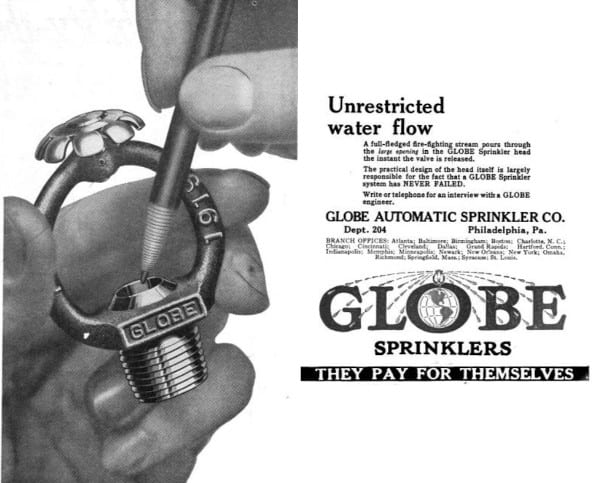
Over the 20th century, Globe enriched the industry with innovations like the SaveAll™ Center Strut Sprinkler—which used heat-activated chemical pellets in the place of traditional fusible links—and its embrace of the small, color-coded glass bulbs now ubiquitous in modern sprinkler design. In a centennial tribute published in Fire Protection Contractor Magazine, Globe’s director of marketing suggested that the decision even influenced their competitors’ choices:
At a time when the North American market was dominated by link-style sprinklers, Globe made the bold move to phase out its line of ‘traditional’ sprinklers in favor of small-diameter glass bulbs…
“Dad was two steps ahead of the market,” noted son and President Steven. While there are specifications remaining that call for link-style sprinklers, the North American market made a rapid shift from fusible element sprinklers to glass bulbs in the 1990s.
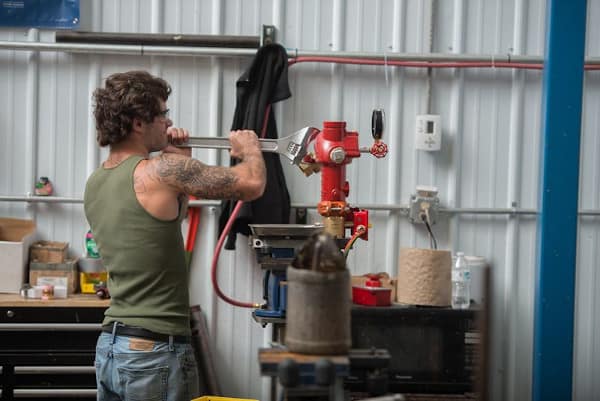
Viking, like Tyco, stands as a multi-industry titan with a strong presence in fire sprinkler manufacturing
Short take: A Swedish polymath leaves behind a legacy that encompasses more than just fire sprinklers.
Like Reliable, the Viking Group began as one immigrant’s story: after losing his factory to fire, Swedish inventor and manufacturer Emil Tyden pivoted from manufacturing equipment for railroad cars to developing sprinkler heads. His partnerships with experts across the United States led to enormous growth.
Viking and its affiliates gradually transitioned from an all-in-one manufacturing and installation service to a manufacturer and distributor of fire safety products. Tyden’s work was later recognized by the American Swedish Historical Museum, which featured his sprinklers in a 1948 exhibit touting the photographs, weapons, sculptures, and engineering achievements of Swedish emigrants.
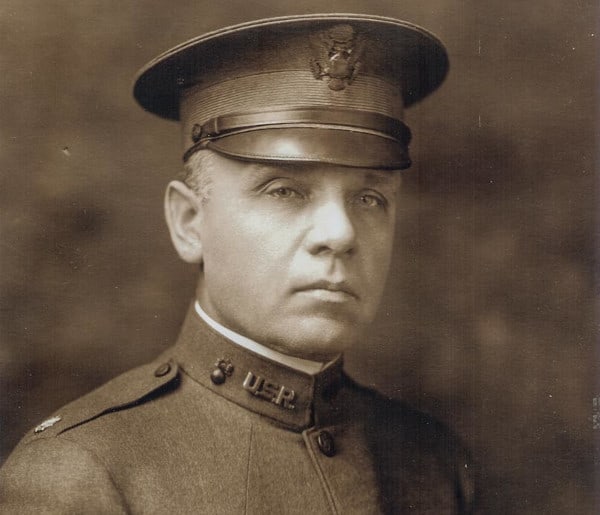
Today, the Viking Group continues a long tradition of innovation. Recently, the company released a revamped line of fire sprinkler heads and accessories—the XT1 platform—designed to combat corrosion, simplify installation, and improve reliability. Other recent innovations include:
- Custom logos and artwork for nearly any Viking cover
- Adapters that eliminate the need for thread seal tape when installing fire sprinkler heads.
- Stainless steel cover plates and other fire safety equipment designed especially for cleanrooms.
- High-volume storage sprinklers that protect tall warehouses—with ceilings as high as 48 feet—without in-rack heads.
The market for fire protection is booming—and so are consumers’ options
Each year, the American Fire Sprinkler Association hosts “the largest fire sprinkler exhibit in North America.” And with more than a hundred past exhibitors offering a wide range of products, there’s a good chance that consumers can turn to companies other than those listed above. Over a hundred manufacturers worldwide—past and present—have a registered sprinkler identification number (SIN), a code imprinted on nearly every sprinkler made since late 2000.
But these fire sprinkler head manufacturers are thriving for a reason: each brings a wealth of experience—in invention, production, and distribution—to the table.
For a deeper look at these industry leaders and their offerings, check out our related articles:
- Guide to Fire Sprinkler Head Types
- Victaulic Fire Sprinkler Escutcheons
- Viking Fire Sprinkler Escutcheons
- Tyco, Gem, Star, and Central Fire Sprinkler Escutcheons: The Complete Guide
- Replacing Central Sprinkler Cover Plates
- Tyco LFP: The Industry’s First UL-Certified Antifreeze
- XT1 Fire Sprinklers: Viking’s “Next Generation”
Questions? Call us at +1 (888) 361-6662 or email support@qrfs.com.
This blog was originally posted at blog.qrfs.com. If this article helped you, check us out at Facebook.com/QuickResponseFireSupply or on Twitter @QuickResponseFS.


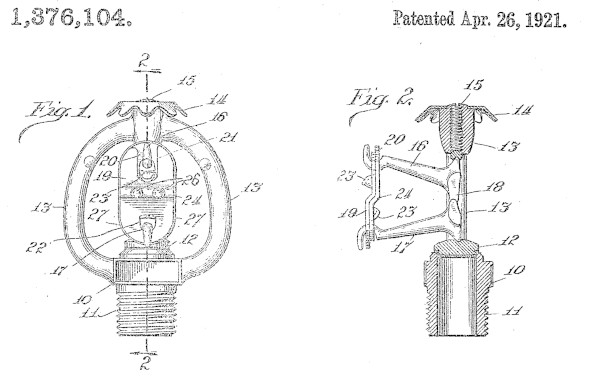
Hello sir
We need Fire extinguishing sprinklers, American made modern machine guns(sidwall sprinkler )(quick response) withstands temperature up to 68 degrees celsius it has awater discharge cofficient (k-factor) not less than 5.60 it can withstand even water pressure up to 12 bar and is included with menus(ul)and (ul listed)
Mohsen — We’ve forwarded your request to QRFS customer service, and they should be in touch shortly. You can get faster service in the future by emailing them directly at support@qrfs.com. Thanks!